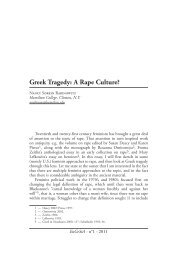Perspectives On and Of Livy's Tarpeia - EuGeStA
Perspectives On and Of Livy's Tarpeia - EuGeStA
Perspectives On and Of Livy's Tarpeia - EuGeStA
You also want an ePaper? Increase the reach of your titles
YUMPU automatically turns print PDFs into web optimized ePapers that Google loves.
180 TaRa WeLCh<br />
bility during a monarchy than during the Republic 26 ; <strong>and</strong> historiographically,<br />
as markers of disruption in the world of men 27 .<br />
My analysis also combines the historical with the historiographical.<br />
In this section I argue that Livy’s women are especially memorable <strong>and</strong><br />
rich characters – <strong>and</strong> especially vexed – in that they are “readability” personified.<br />
Their very position as women, acting in the world of men but<br />
with their own voices for the most part muted, situates them as objects<br />
of spectacle <strong>and</strong> thus of interpretation from various perspectives. These<br />
various perspectives on them emerge from their role as the “coin of the<br />
realm” in transactions between families <strong>and</strong>/or between communities;<br />
they come from one household <strong>and</strong> marry into another, thus bridging<br />
natal <strong>and</strong> marital families within a community, or even, as in many cases,<br />
linking one community to another. Thus situated at a crux of people <strong>and</strong><br />
identities, woman is also predisposed to having multiple perspectives. In<br />
the best cases (the sabine women, Lucretia) 28 , her objective identities <strong>and</strong><br />
her interests come to overlap, <strong>and</strong> woman bridges solidly <strong>and</strong> seamlessly<br />
the gap between the way(s) she is viewed <strong>and</strong> the way(s) she views. <strong>Tarpeia</strong><br />
is not so lucky, nor is the heroine of one other extended tale in the<br />
book: horatia. These two stories together reveal that unmarried women<br />
are especially vulnerable to the push-<strong>and</strong>-pull of divergent perspectives<br />
because, prone themselves to look beyond their fathers/fatherl<strong>and</strong>s to<br />
the outside, they have not yet accomplished the assimilation of outside<br />
perspectives into the Roman consciousness, assimilation which softens<br />
Roman expansion.<br />
Gary Miles has analyzed story of the rape of the sabine women 29 .<br />
Using resources from anthropology <strong>and</strong> from Roman law, Miles argued<br />
that this story reenacts – or, rather, pre-enacts – the dynamics of the<br />
Roman marriage ceremony – not just specific practices in the marriage<br />
ritual, but also in some ideologies <strong>and</strong> tensions that underlie Roman<br />
marriage: e.g., the prowess <strong>and</strong> ingenuity of the Roman men, both collectively<br />
<strong>and</strong> individually, the vulnerability of women to that ingenuity,<br />
26 — Glinister 1997.<br />
27 — here fit the interpretations of Lucretia <strong>and</strong> verginia as symbols of political malaise<br />
(Joplin 1990, Joshel 1992), <strong>and</strong> Milnor’s 2009 study of women operating in the public sphere as an<br />
indication of men’s failure to keep them at home. Consider also Tullia’s willingness to be in the forum<br />
or senate house, Livy 1.48.5: her boldness is a symbol of superbus’ arrogant, transgressive power <strong>and</strong><br />
a tip-off that the state is in disharmony (see particularly Milnor 2009: 282-3).<br />
28 — In the case of both sabine women <strong>and</strong> Lucretia, not only are fathers <strong>and</strong> husb<strong>and</strong>s<br />
aligned, but these overlap (or come to overlap) the needs of the state as well. The sabine women’s<br />
plea to husb<strong>and</strong>s <strong>and</strong> fathers to cease their violence leads to an assimilation into one, stronger state<br />
<strong>and</strong> a joint kingship; <strong>and</strong> Lucretia (1.58.5) has so blended her natal <strong>and</strong> marital families that she calls<br />
her father <strong>and</strong> husb<strong>and</strong> to help her, <strong>and</strong> their subsequent actions benefit <strong>and</strong> strengthen the state.<br />
29 — he analyzes five versions: Cicero de Republica 2.12-14; Livy 1.9-13; dionysius<br />
halicarnassus 2.30-47; Ovid Fasti 3.167-258; <strong>and</strong> Plutarch Romulus 14-20.



